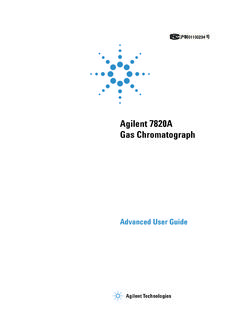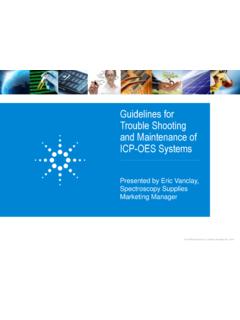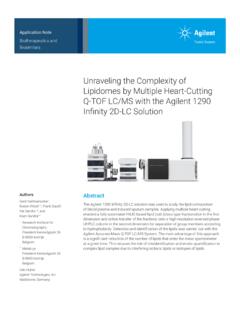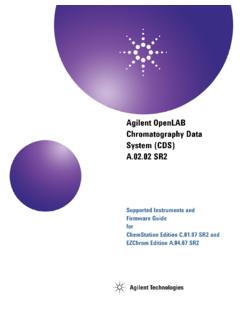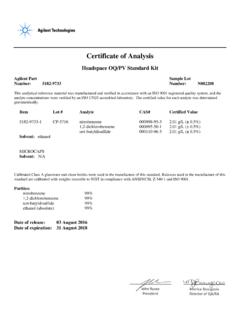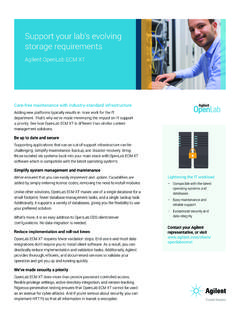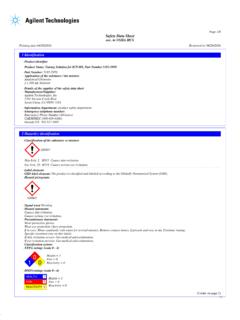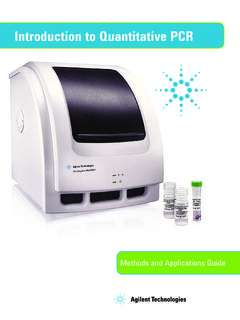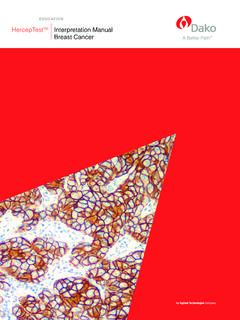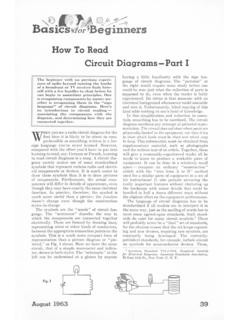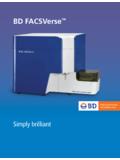Transcription of Quantitative Analysis of Underivatized Amino Acids …
1 Application NoteFood Testing, Metabolomics, Agricultural Chemistry, EnvironmentalAuthorsYuxiong Huang, Weiwei Li, and Arturo Keller University of California, Santa BarbaraTarun Anumol and Adam Bivens Agilent Technologies, Application Note presents a method for Quantitative Analysis of a wide range of Underivatized Amino Acids by triple quadrupole LC/MS. Sensitivity, linearity, and recovery are shown to be excellent, even in the presence of significant amounts of plant matrix (cucumber plant tissue extract). Hydrophilic interaction chromatography (HILIC) was used to separate the highly polar Amino Acids . The next generation Agilent InfinityLab Poroshell 120 HILIC-Z phase was used to take advantage of its excellent resolution and peak shape under LC/MS friendly Analysis of Underivatized Amino Acids in Plant Matrix by Hydrophilic Interaction Chromatography (HILIC) with LC/MS Detection2 IntroductionA wide range of Amino Acids are present in plant material at parts-per-million (ppm) and parts-per-billion (ppb) levels.
2 As previously found1, Underivatized Amino Acids can be analyzed with excellent resolution and sensitivity using hydrophilic interaction chromatography (HILIC) mode with low pH solvents and positive mode MS detection. These conditions were further optimized in this Application Note for Quantitative Analysis of Amino Acids in plant matter. Reagents and chemicalsAll reagents were HPLC grade or higher. Ultra LC/MS grade acetonitrile was bought from Baker (Center Valley, PA, ). Water was purified using an EMD Millipore Milli-Q Integral System (Darmstadt, Germany). Reagent-grade formic acid (FA, p/n G2453-85060) was from Agilent Technologies. Ammonium formate and Amino acid standards were purchased from Sigma-Aldrich (St. Louis, MO, USA).
3 Amino Acids were stored at 70 C until day of use. Agilent InfinityLab fittings Column front: Agilent InfinityLab Quick Connect LC fitting (p/n 5067-5965) Column back: Agilent InfinityLab Quick Turn LC fitting (p/n 5067-5966) Agilent vial, screw top, amber, write-on spot, certified, 2 mL (p/n 5182-0716) Agilent bonded screw cap, PTFE/red silicone septa (p/n 5190-7024) Eppendorf pipettes and repeater Vortexer and multitube vortexers (VWR, Radnor, PA, USA) Agilent InfinityLab solvent bottle, amber, 1,000 mL (p/n 9301-6526) Agilent InfinityLab Stay Safe cap, GL45, 3 ports, 1 vent valve (p/n 5043-1219) Centrifuge (VWR, Radnor, PA, USA) Sonicator (VWR, Radnor, PA, USA)Instrumentation Agilent 1260 Infinity binary pump (G1312B) Agilent 1260 Infinity autosampler (G7129A) Agilent 1260 Infinity thermostatted column compartment (G1316A)
4 Ultralow dispersion kit for Agilent 1290 Infinity LC Series (5067-5189) Agilent MassHunter workstation software Agilent 6470 triple quadrupole LC/MS Agilent Jet Stream Electrospray ionization sourceSample preparationThe Amino acid standards were mixed to stated concentrations in water, and analyzed with no further sample preparation. The following deuterated and 15N-enriched internal standards (ISTD) were added to each sample to a final concentration of 1,500 ng/mL: isoleucine-15N1, methionine-d8, alanine-d3, glycine-d2, glutamic acid-15N1, aspartic acid-d3, and plant tissue extracts were prepared from freshly harvested cucumber leaves, which were immediately placed in liquid nitrogen for rapid freezing. The frozen cucumber tissues were homogenized in liquid nitrogen into a fine powder using a mortar and pestle, then stored in a freezer Instrument conditionsHPLC ConditionsColumnAgilent InfinityLab Poroshell 120 HILIC-Z 100 mm, m, (p/n 685775-924)Mobile phase A20 mM ammonium formate in water at pH = 3 Mobile phase B20 mM aqueous ammonium formate at pH = 3 in 9.
5 1 acetonitrile/waterFlow mL/minColumn temperature25 CInjection volume1 LTotal run time15 minutesGradientTime (min) %B 0 100 70 12 100MS ConditionsIonization modeESI PositiveGas temperature330 CGas L/minNebulizer35 psiSheath gas temperature390 CSheath gas flow12 L/minCapillary voltage1,500 VNozzle voltage0 V3 Data collectionIndexStart time (min)Scan typeIon modeDiverter valveDelta EMVS tore10dMRMESI + Agilent Jet StreamTo + Agilent Jet StreamTo MS200 Yesat 85 C. For extraction, 100 mg of frozen cucumber leaf powder was weighed into 2-mL Eppendorf microcentrifuge tubes, and 1 mL of M aqueous HCl was added. The tubes were vortexed at 8,000 rpm for 20 minutes, sonicated in a 25 C water bath for 2 0 minutes, then centrifuged at 20,000 g for 20 minutes.
6 Finally, 250 L of the extraction supernatant was transferred into LC vials with ISTD already added, and the mixture was diluted to 1 mL with 20 % water in ACN. MS ParametersCompoundRetention time (min)Precursor ion (m/z)Product ionsQuant ion (m/z)Collision energy (V)Qual ion (m/z)Collision energy (V)Fragmentor (V) Amino spike recovery tests, the Amino acid standard mix was added to the LC vials along with the extraction supernatant and ISTD mixture before being diluted to 1 mL with 20 % water in ACN. The total increase in Amino acid concentration after dilution was 500, 1,000, and 2,000 phase preparationA 200 mM ammonium formate stock solution was prepared in water and adjusted to pH 3 with formic acid. Mobile phase A (aqueous) was prepared by diluting the stock solution 9:1 in water, and mobile phase B (organic) was prepared by diluting the stock solution 9:1 in acetonitrile (final ionic strength of both mobile phases = 20 mM).
7 4 Results and DiscussionChromatographyThe excellent peak shape and resolving power of the Agilent InfinityLab Poroshell 120 m HILIC-Z allowed the complex mixture of Amino Acids to be separated in under Figure 1. Amino acid standards at a concentration of 500 ng/mL. time (min) ng/mL Standard 22212023 Figure 2. Amino acid standards from Figure 1, with peak heights normalized. time (min)Counts (%) ,7891011121413151816171920212223500 ng/mL Standard 15 minutes (Figures 1 and 2). Baseline separation was also achieved for both the leucine/isoleucine isobars and threonine/homoserine isobars (Figure 3).5 Quantitative analysisQuantitation of each Amino acid was accomplished with a combination of seven-point calibration curves from 50 10,000 ng/mL, and comparison against closely eluting isotope-labeled internal standards (Figure 4).
8 Relative standard deviation (RSD) for response and retention time showed excellent reproducibility from run to run (Table 2). Figure 3. Separation of isobars leucine/isoleucine and time (min)Counts time (min)Counts 104 ABMethionineRelative responseRelative = * x + = = * x + = 4. Example calibration curves for methionine and 1. Calibration and signal-to-noise (S/N).CompoundInternal standardR2 for calibration curve (50 10,000 ng/mL)S/N at 50 acidGlutamic acidAspartic spike recovery test was performed to verify robustness in the presence of matrix. A sample of cucumber tissue was analyzed, followed by the same sample spiked with 500, 1,000, and 2,000 ng/mL of Amino acid standard. The recovery at these different levels is shown as the percentage of measured concentration versus the theoretical value (Table 3).
9 Table 2. Reproducibility of n = 15 samples of cucumber plant tissue extract spiked with 2,500 ng/mL of Amino (2,500 ng/mL)Response RSD (%)RT RSD (%) 3. Recovery tests for cucumber tissue extract spiked with the Amino acid standard mix. Amino acidPre-spike concentration (ng/mL)% Recovery (500 ng/mL spike)% Recovery (1,000 ng/mL spike)% Recovery (2,000 ng/mL spike) <MDL878685 Aspartic <MDL108138160 MDL- Method Detection Level7 ConclusionsUnderivatized Amino Acids were quantitated in plant tissue to trace levels by combining the excellent resolution and peak shape of the Agilent InfinityLab Poroshell 120 HILIC-Z column with the powerful Agilent 6470 Triple Quadrupole LC/MS. The method is shown to be Quantitative , reproducible, and robust even in matrix.
10 Reference1. A. Kennedy, A. Bivens. Methods for the Analysis of Underivatized Amino Acids by LC/MS. Agilent Technologies Application Note, publication number 5991-8582EN, This information is subject to change without notice. Agilent Technologies, Inc. 2018 Printed in the USA, January 23, 2018 5991-8922EN
